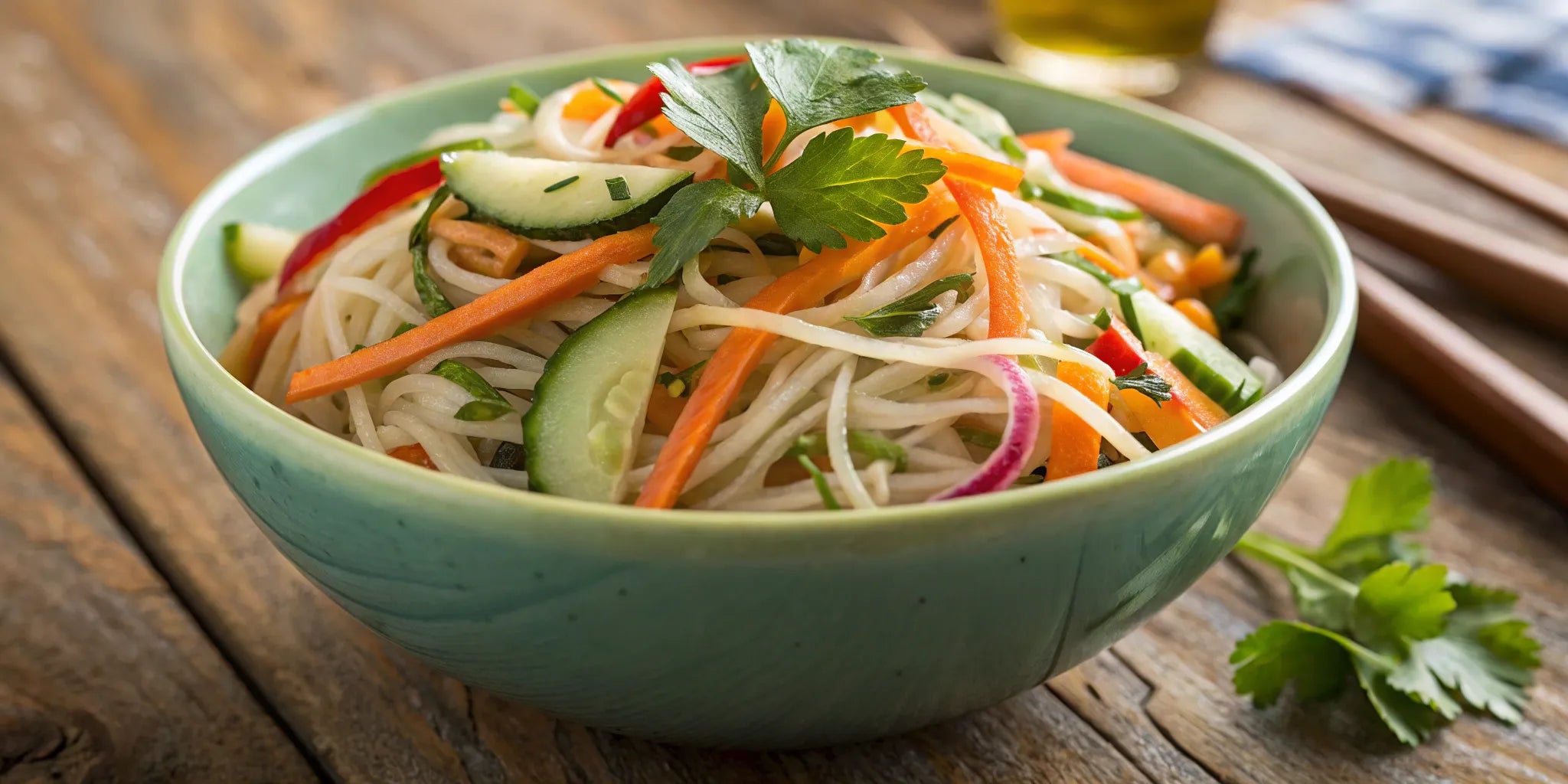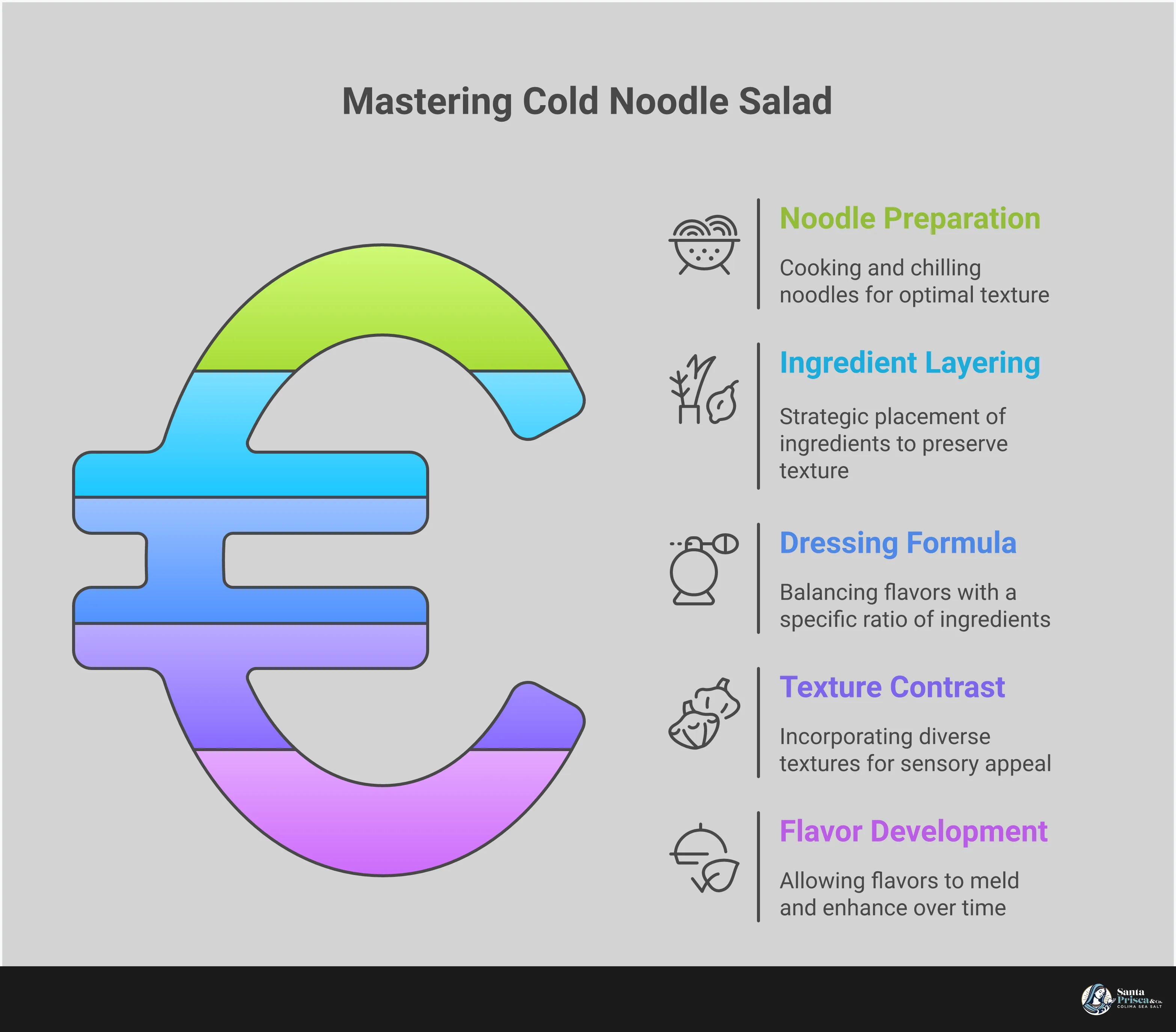Refreshing Cold Noodle Salad Recipe: Easy & Flavorful
Written By Santa Prisca & Co Staff Last updated on
A truly great salad engages all the senses. It begins with the vibrant colors of freshly chopped vegetables—deep purples, bright oranges, and vivid greens. Then there’s the sound, that satisfying crunch with every bite. You notice the aroma of fresh cilantro and zesty lime before the bowl even reaches the table. This noodle salad recipe cold is exactly that: an experience. It’s a beautiful tangle of textures, from the tender, chilled noodles to the crisp snap of snow peas and the nutty depth of toasted sesame seeds. Each forkful is a delightful combination of savory, sweet, and bright flavors, creating a dish that feels both incredibly alive and deeply grounding.
Key Takeaways
- Prepare Your Noodles with Intention: The texture of your salad starts with the noodles. Season the cooking water with a quality sea salt to build flavor from the inside out, cook just to al dente, and rinse under cold water to stop the cooking process and prevent sticking.
- Embrace Seasonality and Thoughtful Layering: Use the freshest vegetables the season has to offer for the most vibrant flavor and crunch. When assembling, layer your ingredients to protect delicate items and ensure every bite has a perfect mix of textures.
- Unify Flavors with a Final Touch: A well-balanced dressing brings the salad together, but the final seasoning is what makes it memorable. A last-minute taste and a finishing pinch of mineral-rich sea salt will awaken and harmonize all the individual flavors.
What You'll Need for a Refreshing Cold Noodle Salad
Gathering your ingredients is the first step in any kitchen ritual. For this vibrant salad, we’re focusing on fresh, whole foods that come together to create something truly nourishing. Think of this list as a guide—feel free to let the season or your cravings inspire you.
The Foundation: Noodles & Mineral-Rich Sea Salt
The base of this salad is a beautiful tangle of noodles. While traditional ramen is a wonderful choice, you can also explore the delightful textures of soba, udon, or even gluten-free rice noodles. We’ll be creating our own dressing, so you can set aside the seasoning packet that often comes with packaged ramen. This gives us complete control over the flavor and allows us to use pure, high-quality ingredients. When you cook your noodles, add a generous pinch of Colima Sea Salt to the water. This seasons them from the inside out, infusing them with a subtle mineral depth that lays the perfect foundation for the other flavors to build upon.
Crisp Vegetables & Aromatic Herbs
This is where the salad truly comes to life. We’re looking for color, crunch, and freshness. Thinly sliced bell peppers, crisp cucumbers, and shredded carrots add a wonderful sweetness and texture. You can find great inspiration for vegetable combinations that work well together. Don’t forget fresh herbs. A handful of chopped cilantro or mint can transform the entire dish, lending an aromatic brightness that cuts through the richness of the dressing. Use what looks best at the market or what you have growing in your garden. This is your moment to connect with the season.
Your Choice of Protein
To make this a satisfying, complete meal, a little protein goes a long way. This is a perfect opportunity to use leftover cooked chicken or to quickly grill a piece of salmon seasoned simply with salt and pepper. Poached shrimp is another light and refreshing option. By adding a clean source of protein, you turn a simple side dish into a balanced meal that will keep you feeling energized and full. You can find some excellent protein ideas to get you started, ensuring your salad is as nourishing as it is delicious.
How to Prepare the Noodles
The heart of any noodle salad is, of course, the noodles themselves. Preparing them with intention is the first step toward a truly memorable dish. It’s a simple process, but a few thoughtful details can make all the difference between a good salad and a great one. From choosing the right variety to cooking it with care, these steps lay the foundation for a refreshing and satisfying meal that feels both nourishing and special.
Choose the Right Noodle
The beauty of a noodle salad is its versatility, which starts with your choice of noodle. There are many wonderful types of noodles to explore, each offering a unique character. Earthy, buckwheat soba noodles lend a firm, nutty bite, while delicate vermicelli rice noodles are light and absorb dressing beautifully. For a chewier texture, consider udon. You could even use a favorite gluten-free pasta. There is no wrong answer here. Consider the texture you’re craving and the other ingredients you plan to use. Each noodle provides a unique canvas for the flavors you’ll build upon.
Cook to the Perfect Texture
The key to a perfect cold noodle salad is to cook your noodles just until they are al dente—tender, but with a slight firmness to the bite. Bring a generous pot of water to a rolling boil and season it well with a pinch of Colima Sea Salt. This step is fundamental; it seasons the noodles from the inside out, adding a subtle layer of mineral depth that you can’t replicate later. Cooking them perfectly ensures they hold their shape and don’t become soft when tossed with the dressing and other fresh ingredients, giving your salad the ideal structure.
Rinse and Chill for the Best Bite
Once your noodles reach that perfect al dente texture, immediately drain them and rinse under cold running water. This simple step is essential—it halts the cooking process instantly and washes away excess starch that can make the noodles sticky and clump together. After rinsing thoroughly, gently toss them with a light drizzle of toasted sesame or avocado oil. This thoughtful touch keeps each strand separate and silky, ensuring every forkful of your salad is distinct and ready to mingle with the crisp vegetables and vibrant dressing.

Combine Your Fresh Ingredients
This is where the salad truly comes to life. As you prepare each component, you’re not just assembling a meal; you’re layering flavors, textures, and colors that will nourish and delight. It’s a moment to pause and appreciate the vibrancy of fresh food, turning simple preparation into a mindful practice. The thoughtful combination of crisp vegetables, bright herbs, and satisfying crunch is what transforms this dish from good to truly memorable.
Chop Your Seasonal Vegetables
The soul of this salad lies in its fresh, crisp vegetables. Choose what’s in season for the most vibrant flavor. Think thin ribbons of carrot, jewel-toned slices of red cabbage, and sweet, crunchy bell peppers. As you chop, notice the unique texture and aroma of each one. This simple act connects us to our food in a meaningful way. A colorful medley not only adds visual appeal but also provides a wonderful textural contrast to the soft noodles, creating a dish that feels both light and satisfying.
Prepare Your Herbs and Garnishes
Fresh herbs are the finishing touch that awakens the entire dish. Their bright, aromatic notes cut through the richness of the dressing and add a layer of complexity. Finely chopped cilantro offers a fresh, citrusy lift, while thinly sliced green onions provide a mild, sharp bite. Consider a sprinkle of toasted sesame seeds for a nutty depth. These small additions are what bring a sense of intention to your cooking, showing care in every detail and making the final dish feel complete.
Add a Little Crunch
Texture is everything in a great salad. A satisfying crunch provides a delightful contrast to the tender noodles and dressing. Consider adding roasted peanuts, crisp snow peas, or shelled edamame for a pop of texture and a dose of plant-based protein. This final layer makes each bite more interesting and fulfilling. For a finishing touch, a sprinkle of hand-harvested Colima Sea Salt not only balances the flavors but adds a delicate, crystalline crunch that lingers on the tongue, offering a subtle burst of mineral depth.
Whisk Together a Flavorful Dressing
A dressing is what brings a salad to life, tying all the beautiful, fresh ingredients together. Whether you prefer something with a bit of warmth and depth or a dressing that’s bright and sunny, the key is to create a balance of flavors. Here are two simple approaches that you can whisk together in just a few moments.
A Classic Asian-Inspired Vinaigrette
For a dressing that complements the crisp vegetables and tender noodles, I often turn to a classic combination of soy sauce, fresh lime juice, rice vinegar, garlic, and ginger. The deep umami from the soy sauce is balanced by the bright acidity of the lime, while the ginger adds a gentle, warming spice. A similar approach is found in a beautiful ginger lime dressing that uses avocado oil for a smooth finish. This vinaigrette is wonderfully simple and allows the fresh ingredients in your salad to truly shine.
A Bright Mediterranean-Style Dressing
If you’re craving a taste of the Mediterranean, a bright, herb-forward dressing is a perfect choice. Think of a high-quality olive oil, a generous squeeze of fresh lemon juice, and a handful of finely chopped herbs like basil or parsley. This combination is clean, zesty, and incredibly refreshing. It feels like sunshine in a bowl. The simplicity of this dressing relies on the quality of its parts, so use the best olive oil you have to let its grassy, fruity notes come through.
Balance Flavors with Colima Sea Salt
No matter which dressing you choose, the final, essential touch is a pinch of good salt. Salt does more than just add its own flavor; it harmonizes the acidity from the vinegar or citrus and amplifies the other ingredients. A truly special salt, like our hand-harvested Colima Sea Salt, brings a clean, mineral depth to the dressing. Its crisp, delicate flake dissolves beautifully, ensuring every bite is perfectly seasoned. This small, intentional step makes all the difference, turning a simple dressing into something truly memorable.
Assemble and Store Your Salad
Bringing your salad together is the final, beautiful step where individual ingredients become a harmonious meal. This is where the textures and flavors you’ve carefully prepared get to meet, creating something truly special.
Layer for the Best Flavor
To build a salad that stays crisp and vibrant, think in layers. Begin by placing the heartier, heavier vegetables at the bottom of your bowl. Next, gently add your protein and the cooked noodles. Finally, pour the dressing over the top. When you’re ready to serve, toss everything together with care. This simple layering method ensures the more delicate ingredients don’t get bruised and every bite is perfectly coated.
Chill Before Serving
Here’s a small act of patience that yields delicious results: let your salad rest. Once assembled, cover the bowl and place it in the refrigerator for at least 30 minutes. This brief chill time is essential, as it allows the flavors to meld and deepen, transforming the dish from a simple mix of ingredients into a truly cohesive salad. If you have an hour to spare, the result will be even more pronounced.
How to Store Leftovers
Should you have any salad left, it stores beautifully for a few days. Transfer the leftovers into airtight containers and keep them in the refrigerator for up to four days. The flavors will continue to develop, making for a wonderful lunch the next day. Just be sure not to freeze the salad, as the texture of the noodles and fresh vegetables will change upon thawing.
Simple Serving Ideas
A thoughtful garnish is the perfect finishing touch. Before serving, consider sprinkling the salad with toasted sesame seeds, chopped peanuts for a satisfying crunch, or a handful of fresh, aromatic cilantro. For a final burst of mineral depth, finish with a light dusting of our Colima Sea Salt. Its crisp, clean flake lingers on the tongue and brightens all the other flavors in the bowl.
Make This Recipe Your Own
A recipe is more than a set of instructions; it’s a starting point for your own creativity. Think of this cold noodle salad as a canvas. The real beauty of a dish like this is its flexibility—how it can shift and change with the seasons, your pantry, and your personal tastes. This is your invitation to connect with your ingredients and make this meal a true reflection of what nourishes you. Don’t be afraid to experiment. The most memorable meals often come from these small, thoughtful adjustments.
Adapting for Dietary Needs
Honoring your body’s needs is the first step to intentional eating. This salad is wonderfully easy to adapt for different dietary preferences. If you have a nut allergy, for example, you can create a beautifully creamy dressing by swapping the peanut butter for sunflower seed butter or tahini. For a gluten-free version, simply choose noodles made from rice, sweet potato, or buckwheat—just be sure to check the label, as some soba noodles contain wheat. The goal is to create a dish that everyone at your table can enjoy with peace of mind.
Swap Ingredients with the Seasons
Let nature be your guide. One of the best ways to bring this salad to life is by using vegetables that are in season. In the spring, you might add crisp sugar snap peas and thinly sliced radishes. Summer calls for sweet corn, vibrant bell peppers, and juicy cherry tomatoes. As the weather cools, you could add heartier textures like shredded kale or roasted butternut squash. Visiting a local farmers market is a beautiful way to discover what’s fresh and support your community, turning your meal into a celebration of the present moment.
Play with Textures and Temperatures
This salad is delightful served cold, straight from the refrigerator, which allows the flavors to become crisp and distinct. However, it’s just as lovely at room temperature, making it perfect for picnics or potlucks. For the best experience, I recommend letting the assembled salad rest for at least 30 minutes before serving. This gives the noodles time to absorb the dressing and the flavors a chance to meld into a more harmonious whole. Notice how the textures of the crunchy vegetables play against the soft noodles—it’s a simple pleasure worth savoring.
Tips for Making It Ahead
Preparing food in advance is a wonderful act of self-care, and this salad is perfect for it. In fact, the flavors deepen and become even more complex overnight, making it an ideal dish for meal prepping. You can store it in an airtight container in the refrigerator for up to three days. If you plan to make it ahead, consider keeping the dressing separate and tossing it with the salad just before serving to maintain the freshest crunch from the vegetables. This little bit of planning can bring ease to a busy week.
A Few Final Notes for Success
Before you head to the kitchen, I want to share a few final thoughts. Think of these as the little details that transform a good dish into a truly memorable one—the kind of meal that feels both nourishing and special.
Common Mistakes to Avoid
A beautiful cold noodle salad is all about texture and fresh flavor. To keep everything just right, remember to cook your pasta until it’s perfectly al dente. This ensures it holds its shape and offers a satisfying bite.
Once cooked, give the noodles a good rinse under cool water and let them chill completely before mixing. Adding warm pasta to crisp vegetables can cause them to wilt. An Italian pasta salad recipe often calls for at least 30 minutes in the refrigerator, which gives the flavors a chance to meld beautifully.
A Note on Portion Sizes
This salad is designed to be light on the palate and wonderfully satisfying. If you’re mindful of your intake, it helps to know that a single serving is quite balanced.
Many recipes for a cold noodle salad with peanut dressing come in at around 280 calories per serving. It’s a perfect portion for a light lunch or a vibrant side dish that leaves you feeling energized.
Finish with a Thoughtful Garnish
The final touches are where you can add a signature layer of texture and aroma. A thoughtful garnish brings the whole dish to life.
Consider a sprinkle of toasted sesame seeds, a handful of roughly chopped peanuts, or a scattering of fresh cilantro. As this cold noodle salad recipe suggests, these additions aren't just for looks—they add a final burst of flavor and a delightful crunch to every bite.
Season to Taste Before Serving
Your final act before serving is perhaps the most important: tasting and seasoning. One simple tip is to gently shake any excess water from your noodles after rinsing them. This small step ensures your dressing remains rich and doesn't become diluted.
Just before you bring the salad to the table, give it one last taste. A final pinch of our Colima Sea Salt can awaken all the other flavors, adding a burst of mineral depth that ties everything together. It’s the perfect, intentional finish.
Related Articles
- 10 Easy Cold Salad Recipes for a Quick Meal – Santa Prisca & Co
- 8 Delicious Chilled Salad Recipes for 2025 – Santa Prisca & Co
- 5 Easy Grain Salad Recipes for Healthy Meals – Santa Prisca & Co
Frequently Asked Questions
Can I prepare this salad in advance? Absolutely. This salad is wonderful for meal prepping, as the flavors have a chance to deepen and meld together in the refrigerator. You can store it in an airtight container for up to three days. For the best texture, you can keep the dressing separate and toss everything together just before you plan to eat.
Do I really need to rinse the noodles after cooking them? Yes, this is a small step that makes a huge difference. Rinsing the cooked noodles under cold water immediately stops the cooking process, which prevents them from becoming too soft. It also washes away excess starch, keeping the noodles from clumping together and ensuring a silky, separate texture in your finished salad.
What are the best noodles to use for this salad? The beauty of this recipe is its flexibility, so feel free to use what you love or have on hand. Soba noodles offer a lovely, nutty flavor, while rice vermicelli is light and delicate. Udon provides a satisfying chew, and even a favorite gluten-free pasta works perfectly. The goal is to choose a noodle that you enjoy and cook it until it has a slight bite.
How can I adapt this recipe for dietary needs like gluten-free or nut-free? This salad is very easy to adjust. For a gluten-free version, simply use noodles made from rice, sweet potato, or 100% buckwheat. To make it nut-free, you can replace any peanuts with toasted sunflower seeds for crunch and use tahini or sunflower seed butter in the dressing to achieve a similar creamy consistency.
Does the kind of salt I use really make a difference? It truly does, especially in a dish with such clean flavors. A high-quality, unrefined sea salt does more than just make food salty; it enhances and balances all the other ingredients. When you use a mineral-rich salt like Colima Sea Salt in the noodle water and dressing, you’re adding a subtle depth and clean finish that you just don’t get from a more processed salt.

